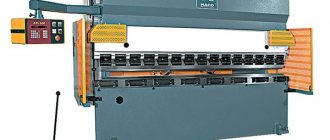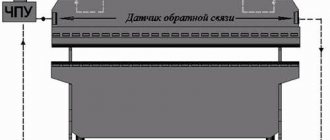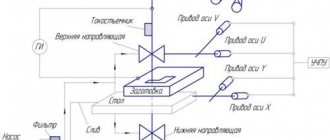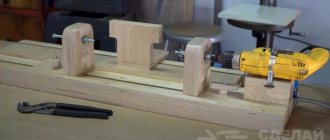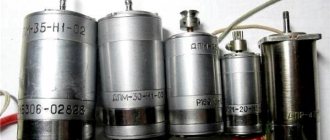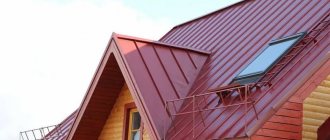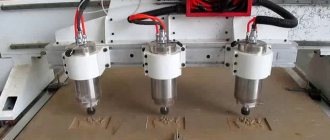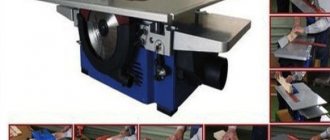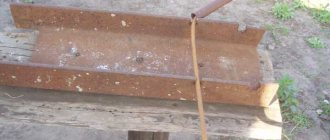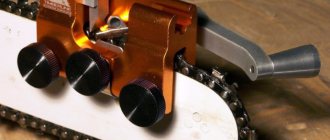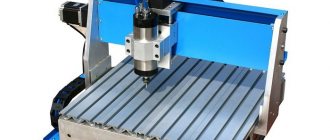It is not difficult to make a sheet metal bending machine with your own hands, but so far few of the home craftsmen and specialists who use the necessary forms from sheet steel in their business are creating such equipment for personal needs. Meanwhile, a similar device, which is quite durable and easy to operate, will help you save a lot.
In particular, the production and use of a machine for bending sheet metal with your own hands is important for those who need to perform technological actions for bending sheet metal not every day and in large volumes, but from time to time.
Types of sheet benders and their mechanism
Before you start making a sheet bending machine with your own hands, you need to clearly establish a list of tasks for which you need it. The main purpose of such a device will depend on what scheme it will be made according to. The most elementary is the mechanism in which sheet iron is bent using a special traverse. Using such a device, you can easily bend a sheet of metal at an angle of 90 degrees, using only hand strength without additional devices, if the width of the sheet is not more than 0.5 meters.
The base of the sheet is fixed using clamps or a vice, and its bending is carried out due to the pressure exerted by the traverse.
In certain cases, to obtain a turning angle of exactly 90 degrees, an embedded attachment may be useful , which is an ordinary strip of metal that will help compensate for the elasticity of the sheet.
A press brake, the system of which consists of a mesh and a punch, is considered more complex in design. Sheet iron in such a device is located on a matrix, and a punch descends onto the workpiece from above, giving it the required profile. In economic conditions, a sheet bending machine is unlikely to be used, since it is quite complex and unsafe to use.
A variation of the implementation of a homemade sheet metal press, operating in tandem with a self-made hydraulic press. If you already have a press, then adding devices for bending narrow sheets of metal will not be difficult. A sheet bending machine is considered more advanced, in which bending of iron is performed due to the action of three shafts .
This type of equipment is called a pass-through. One of its main advantages is that its controlled rollers allow different bending radii. A similar apparatus for bending metal can be manually or galvanically driven, and its rollers can have a variety of designs.
- Rollers with a smooth working surface are designed for performing many sheet metal works, which involve bending workpieces, manufacturing pipe sections with large diameters, etc.
- Profiled rollers are needed for bending parts of roofing units (ridges, boxes, gutters, flanges, etc.).
- The broaching machine can be equipped with a support, a clamp and a traverse, which allows it to be used for manual bending of blanks.
- Similar machines are equipped with a set of shafts of different profiles, which can also be purchased additionally to make the machine more versatile.
Where to start production of sheet metal bending machine
To make a machine for bending sheet metal, you will need a drawing of this device or its detailed photos. In addition, it is necessary to take into account a number of significant factors, such as the force that will need to be applied to apply the structure, its weight and size (on which mobility will depend), the initial cost and availability of devices. As a result, there should be the following initial parameters:
- The maximum width of the sheet that will need to be bent is 2 m.
- The greatest thickness of sheet material: galvanized - 0.8 mm, aluminum - 0.8 mm, copper - 2 mm.
- The amount of work courses that will be performed without readjustment or repair is 1300.
- The largest bend angle of a metal profile, purchased without manual finishing, is 130 degrees.
- It is highly undesirable to use workpieces made from specific steels (for example, stainless steel).
- In the sheet bending system, it is necessary to avoid welded installations that do not tolerate alternating loads well.
- It is necessary to reduce as much as possible the number of machine elements that need to be ordered externally, resorting to the help of turret or milling machine operators.
- It is very difficult to find a drawing of a device that would satisfy all requests, but you can complete the most successful template.
Design of a sheet bending machine and its improvement
The installation of a manual sheet metal bending machine can be easily improved. To build a sheet bending machine, this scheme is used:
- Pillow made of wood;
- The main beam is made of channel 10−130 mm;
- Cheek, for the production of which a sheet 7-9 mm wide is used;
- Manufacture sheet subjected to finishing;
- A pressure beam made of 70-90 mm corners connected by welding;
- Rod for rotating the traverse (made from an iron rod with a diameter of 11 mm);
- The spacer itself is an angle with dimensions of 90-110 mm;
- The handle of the device is made of a rod with a diameter of 12 mm.
The sheet bending traverse, which according to the initial drawing is planned to be made from a corner, conventionally shows an option made from a channel. Such an improvement will several times increase the endurance of the traverse, which, when using a corner, at a certain moment will certainly bend in the center and will not form a high-quality sheet bend in this place.
Replacing with a channel will allow you to do not 250 bends without straightening or replacing the provided element (which is quite a bit for more or less constructive work), but more than 1400.
The design of this home-built sheet metal bending machine can be further improved, making it more efficient and versatile.
The second option allows you to understand in more detail the installation of a homemade sheet bender:
- A homemade clamp made from a suitable angle (50-70 mm) and a screw with a heel and a knob;
- Cheek;
- Beam acting as the reference point of the machine;
- Pressure beam bracket made from 120 mm angle iron;
- The pressing beam of the sheet bender itself;
- Traverse rotation axis;
- The traverse itself;
- Strengthening the pressure beam.
Below is a diagram of increasing the pressure bar. However, if you initially use a rather powerful corner as a clamp, and you don’t plan to bend extremely thick sheets on your sheet bending machine, then you can completely do without reinforcing the clamping bar using the described method .
In order to extend the service life of the pressure beam and make it comparable to the service life of the traverse, it is necessary to increase the provided structural element, which from the very beginning according to the drawing is made of a corner, with a base made of a metal strip with dimensions of 17x90 mm.
The front edge of the provided base must be given an angle of 45 degrees in order to level its area with the plane of the pressing corner itself, and specifically the working edge of the provided element must be chamfered about 3 millimeters. These measures will allow the clamp metal to act not on bending (which is extremely inappropriate), but on compression, thereby increasing the service time without repair many times:
- A special 61 angle bracket attached to the rear flange of the main clamp angle will keep it from bending upward.
- You should also think about milling the lower plane of the pressure beam, which forms the bend.
- The unevenness of the provided plane, according to generally accepted rules, should not exceed fifty percent of the thickness of the workpiece being bent.
- Otherwise, it will not be possible to bend the blank evenly, without a swollen fold line.
It is necessary to keep in mind that you need to submit a beam for milling only when it already has all the welds, since their execution leads to a change in the geometric characteristics of the structure.
How to increase the strength of machine mounts
There is another big drawback in the sheet bending machine - the way it is attached to the work table. Clamps, which are included in the provided device, are a very unreliable type of fastening, especially considering the rapid asthenicity of welding seams. These fastening parts can, in general, be abandoned, which will also eliminate the need to use welded mountings and jaws. The following steps can be used to solve this problem:
- Production of a support beam that will extend beyond the desktop;
- Making U-shaped lugs at the ends of the main beam;
- Fastening the main beam to the work table using bolts (M10) and shaped nuts with claws.
If the improved plate bending design does not have jaws, how do you attach the crossbar to it? This issue can be solved quite simply: use butterfly door hinges, which are traditionally used for hanging heavy iron doors. These hinges, which provide fairly high precision, can be secured using countersunk screws.
You can bend many blanks on a sheet bending machine with a traverse attached to butterfly hinges, since these hinges are very strong:
- Reinforced support beam;
- Flywheel - threaded part;
- Beam that provides pressing of the workpiece;
- Tripod for attaching the installation of elements to the desktop;
- A traverse with which you can bend the workpiece to be cut.
Homemade sheet bending machine from a channel and a corner
Let's consider another way to make a sheet bending machine with your own hands of a simple design for your home workshop.
In this case, a construction corner is also used as a basis, but the base is a piece of channel of suitable size. This idea was shared by the author Samodelki Vitmana.
First, you need to make a sheet metal clamp that will be attached using bolts and wing nuts to the top of the bending fixture structure.
Cut two pieces of corner of the same size. We cut out part of the shelf in them at an angle of 45 degrees and drill holes.
We cut another blank from the construction corner and weld two manufactured parts to it. The clamp is ready.
Next, we proceed to the manufacture of the crimping punch. To do this, cut off a piece of the corner, make cutouts along the edges, and additionally cut grooves for the hinges. We weld a square frame from a profile pipe, which will act as a handle.
We weld the lever handle to the crimping punch. Then we clean the welds with a grinding wheel or flap wheel.
We cut off a piece of channel that will act as the base of the sheet bender. We cut out grooves for hinges along the edges.
We weld the hinges to the punch and the base, and then connect both parts of the structure together.
You need to drill two holes in the channel. We insert long bolts into them and scald them. We put springs on the bolts.
After this, we install the clamping part of the structure and fix it with wing nuts. If desired, the homemade product can be painted.
You can watch detailed instructions on how to make a sheet bending machine with your own hands from a corner and a channel with step-by-step stages of work in the video on our website.
Working with this device is very simple - we clamp the base in a bench vice. You can weld corners to the channel to fix the sheet bender to the table surface using bolts.
Next, insert a sheet of tin between the clamping part and the base and fix the clamp. Using a crimping punch, we bend the workpiece.
Making a zig machine
A zig machine (or crimping mechanism) allows you to bend stiffeners on sheet iron structures, which are called zigs. Such machines are classified as special equipment and can be made with galvanic or manual drive. Manual zig machines, also fixed with a clamp, can be quite small in size and can be carried in an ordinary bag for working tools.
Such devices make it possible to make high-quality flanging in one pass not only on convex products (the same shells of iron containers), but also on straight iron sheets. These devices are simply irreplaceable in the production of individual parts of roofing installations.
The working elements of the zig machine are rollers, and its use allows you to significantly save on the purchase of parts of the roofing structure made in the factory. If you watch a video that shows the operation of this device, it becomes clear that it can be used even at the site of direct installation of the roofing system.
How to make a segment bending machine
If you not only need to bend sheet metal at an angle (for example, when making simple products such as flashings and ridges), but also produce box-shaped parts, we recommend using a segment bending machine.
The idea of this homemade product belongs to the author of the YouTube channel HD karya.
First you need to make a base with a crimping punch. To do this, we cut off two construction corners, make cutouts along the edges for hinges, and then connect both parts using hinges.
The author makes two identical racks from thick metal plates, to which L-shaped brackets are attached. A base with a crimping punch is attached to the posts.
At the last stage, a matrix with removable segments is made from thick metal. We attach it to the support posts. We weld two handles to the crimping punch.
You can watch the author's video for details on how to make a segment bending machine for bending boxes from sheet metal and other parts with your own hands.
At first glance, the design seems very complicated, but if you watch the video, everything will become clear - you can figure it out. The author tried to film in detail all the main stages of assembly.
Tips for choosing a bending machine
To choose the right mechanism for the production of bent elements from sheet iron, you must follow the following tips:
- For a home craftsman who occasionally needs a sheet metal bending machine, a simple device made from improvised materials is quite suitable.
- Those who occasionally carry out roofing installation orders will need a manual machine for bending sheet material and a simple zig machine.
- Professionals who are involved in the long-term production of elements for roofing systems and sheet metal work need a factory-installed sheet metal bending device.
- A manual mechanism for making corrugated sheets will be useful for those who professionally produce parts for roofing structures.
A professional installation, characterized by higher strength and durability, is considered suitable for such specialists, for example, the Russian factory sheet bender SKS-2v1, costing 64 thousand rubles.
Machines for sheet metal work from
provides individuals and organizations with a large selection of machines for sheet metal work:
- Circular cutting equipment;
- Sealing machines;
- Hand rollers;
- Folding mechanisms.
All equipment presented on the site has excellent build quality and ease of use, all machines are in stock.
Separately, it is worth noting the optimal price-quality ratio of the equipment presented. For many years, we have been conducting fruitful cooperation with several manufacturers of machine tool equipment in Russia and abroad, so we are able to offer our customers high-quality machines at reduced prices.
The site contains only the most modern models of machines for sheet metal work, which have already gained respect from Russian entrepreneurs. We are pleased to offer you new and reliable equipment with warranty service and consulting support!
